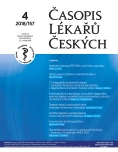-
Medical journals
- Career
Imported skin parasitosis
Authors: Peter Bánovčin; Róbert Rosoľanka; Katarína Šimeková; Mária Szilágyiová; Jana Masná
Authors‘ workplace: Jesseniova lekárska fakulta v Martine Univerzity Komenského v Bratislave, Univerzitná nemocnica v Martine
Published in: Čas. Lék. čes. 2018; 157: 208-210
Category: Case Report
Overview
Larva migrans cutanea is a typical skin parasitosis of tropical and subtropical regions. In Central European countries, such as Slovakia and Czech Republic, larva migrans cutanea is just an imported disease. Its clinical symptoms are characterized by formation of erythematous focus with serpiginous morphology, which is caused by migration of helminth in epidermis. The disease does not threaten the patient’s life, but causes significant discomfort, especially in form of pruritus in the affected area.
Thanks to growing trend of today’s tourism more tourists are exposed to the harmful effects of the environment in final destinations. This leads to an increase in frequency of imported diseases, with which physicians in our latitudes may not have enough experience.
Keywords:
larva migrans cutanea, skin parasitosis, imported skin disease
Sources
1. Padmavathy L, Rao LL. Cutaneous larva migrans – a case report. Indian J Med Microbiol 2005; 23 : 135–136.
2. Šimeková K. Larva cutanea migrans ako importovaná nákaza z Thajska. Interná medicína 2006; 6(1): 25–27.
3. Pánes-Rodríguez A, Piera-Tuneu L, López-Pestana A. Autochthonous cutaneous larva migrans infection in Guipúzcoa. Actas Dermosifiliogr 2016; 107(5): 407–413.
4. Heukelbach J, Feldmeier H. Epidemiological and clinical characteristics of hookworm-related cutaneous larva migrans. Lancet Infect Dis 2008; 8 : 302–309.
5. Zimmerman RF, Belanger ES, Pfeiffer CD. Skin infections in returned travelers: an update. Curr Infect Dis Rep 2015; 17 : 10.
6. Nevoralová Z. Larva migrans cutanea. Časopis lékařů českých 2006; 145 : 325–326.
7. Rosoľanka R, Nováková E. Larva migrans cutanea – importovaná kožná nákaza a možnosti jej liečby. Praktický lékař 2016; 96(3): 141–143.
8. Montgomery SP, Zajac AM, Eberhard ML et al. Hookworms of dogs and cats as agents of cutaneous larva migrans. Trends Parasitol 2010; 26 : 162–167.
9. Švihrová V, Szilágyiová M, Krkoška D et al. Analysis of the direct and indirect costs of treatment of imported malaria in the Slovak republic. Revista da Sociedade Brasileira de Medicina Tropical 2009; 42(4): 377–380.
10. Šimeková K. Rickettsia conori – pôvodca infekcie importovanej z Juhoafrickej republiky. Praktický lékař 2005; 85(10): 573–574.
11. Šimeková K, Stejskal F, Lobovská A. Kožná leishmanióza importovaná občanom Českej republiky z Mexika. Slovenský lekár 2005; 15(3/4): 66–67.
12. Knorr HL, Weber A. Ocular manifestation of selected zoonoses in humans. Tierarztl Prax 1992; 20(4): 347–354.
13. Jackson A, Heukelbach J, Calheiros CM et al. A study in a community in Brazil in which cutaneous larva migrans is endemic. Clin Infect Dis 2006; 43 : 13–18.
14. Indira SP, Bhagirath S. Cutaneous larva migrans in children: a case series from Southern India. Indian J Paediatr Dermatol 2017; 18(1): 36–38.
15. Bouchaud O, Houzé S, Schmiemann R et al. cutaneous larva migrans in travelers: a prospective study, with assessment of therapy with ivermectin. Clin Infect Dis 2000; 31 : 493–498.
16. Albanese G, di Cintio R, Beneggi M et al. Larva migrans in Italy. Int J Dermatol 1995; 34 : 464–465.
17. Pichard DC, Hensley JR, Williams E et al. Rapid development of migratory, linear and serpiginous lesions in association with immunosuppression. J Am Acad Dermatol 2014; 70 : 1130–1134.
18. Tan SK, Liu TT. Cutaneous larva migrans complicated by Loffler syndrome. Arch Dermatol 2010; 146 : 210–212.
19. Sadloňová J, Osinová D, Rozborilová E et al. Importance of GOLD guidelines for chronic obstructive pulmonary disease. Adv Exp Med Biol 2017; 1022 : 45–52.
20. Hochedez P, Caumes E. Hookworm-related cutaneous larva migrans. J Travel Med 2007; 14 : 326–333.
21. Tremblay A, MacLean JD, Gyorkos T et al. Outbreak of cutaneous larva migrans in a group of travelers. Trop Med Int Health 2000; 5 : 330–334.
Labels
Addictology Allergology and clinical immunology Angiology Audiology Clinical biochemistry Dermatology & STDs Paediatric gastroenterology Paediatric surgery Paediatric cardiology Paediatric neurology Paediatric ENT Paediatric psychiatry Paediatric rheumatology Diabetology Pharmacy Vascular surgery Pain management Dental Hygienist
Article was published inJournal of Czech Physicians

-
All articles in this issue
- Hybrid imaging PET/MR in prostatic carcinoma
- Contrast-enhanced ultrasonography
- Coronary CT angiography – current options and future perspectives in the diagnosis of coronary artery disease
- Endovascular recanalization and fast diagnosis improve results of ischemic stroke therapy
- Interventional radiology therapies for liver cancer
- Vertebroplasty and epiduroscopy as seen by interventional radiologist
- Imported skin parasitosis
- Journal of Czech Physicians
- Journal archive
- Current issue
- Online only
- About the journal
Most read in this issue- Hybrid imaging PET/MR in prostatic carcinoma
- Coronary CT angiography – current options and future perspectives in the diagnosis of coronary artery disease
- Contrast-enhanced ultrasonography
- Interventional radiology therapies for liver cancer
Login#ADS_BOTTOM_SCRIPTS#Forgotten passwordEnter the email address that you registered with. We will send you instructions on how to set a new password.
- Career

